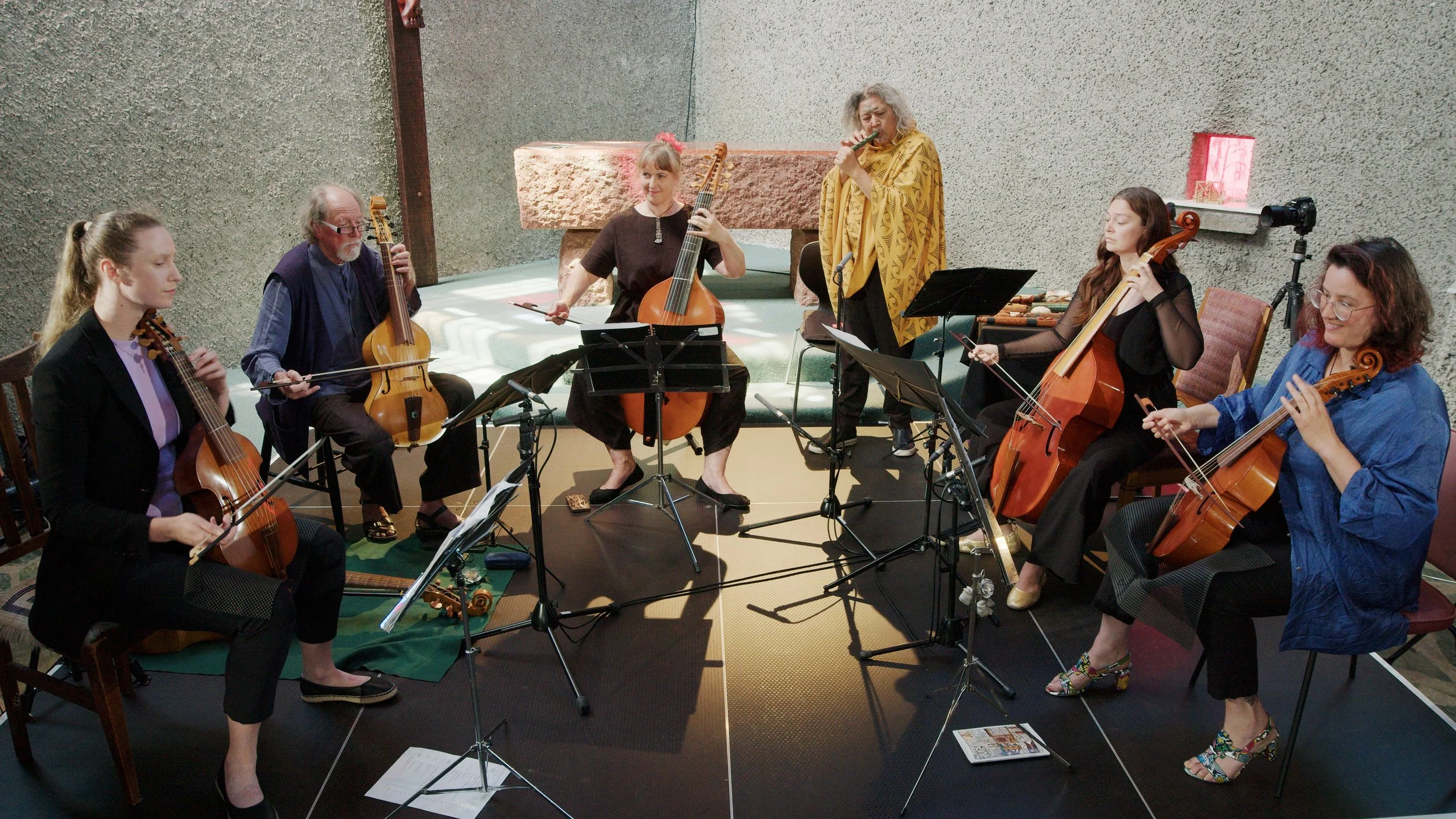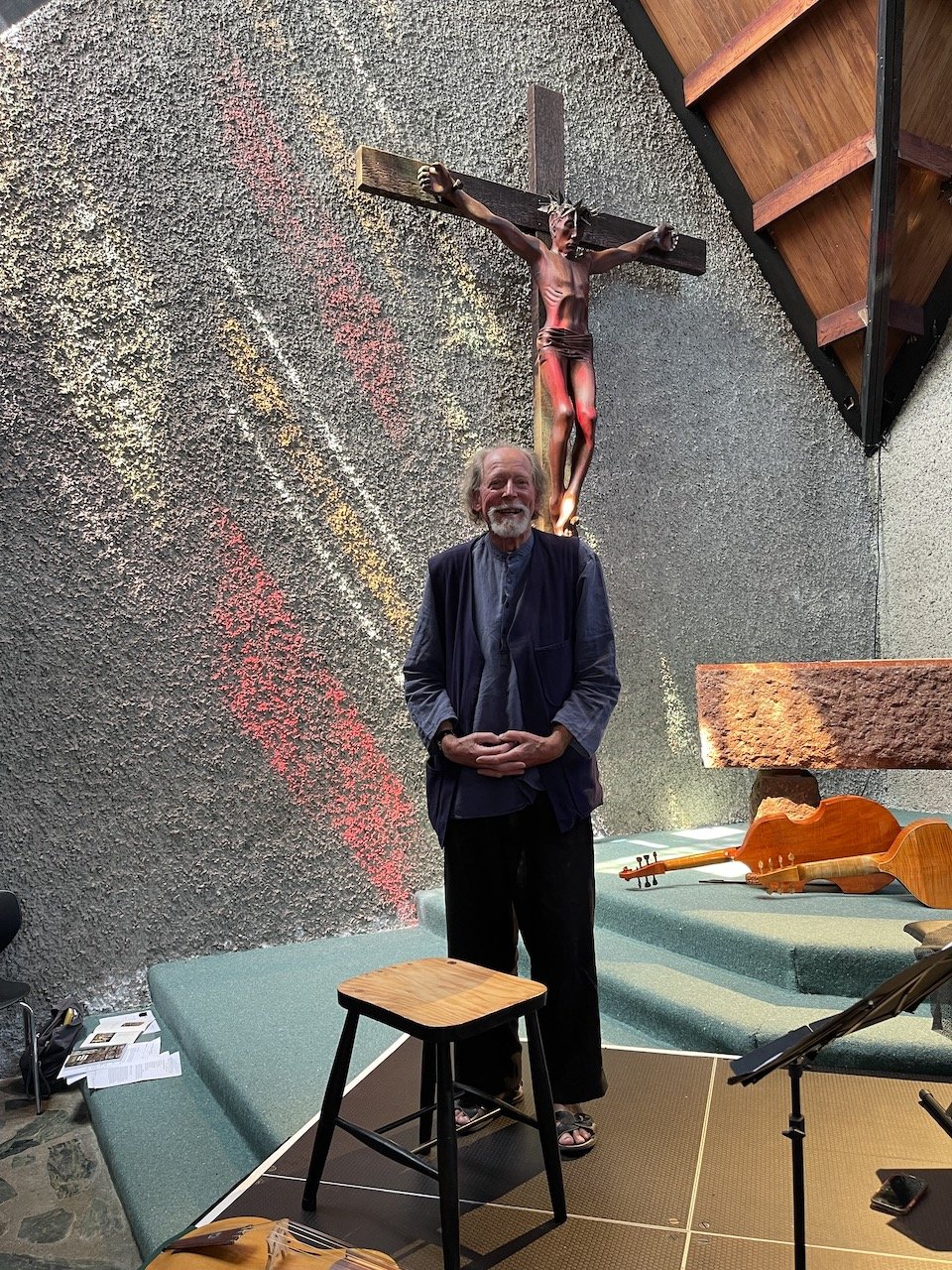Music & Memory: a tribute concert for Barry Brickell
Cover painting for the programme booklet by Gregory O’Brien
A few years after the death of Barry Brickell (1935-2016), potter, railway man and polymath, his brother-in-law, musician Robert Oliver, began devising a tribute event for him. To create something worthy of one of Aotearoa’s most original thinkers, he drew on many aspects of our world and our culture that were dear to them both. The result, called “Music & Memory”, was an extraordinary concert. As the beautifully designed accompanying booklet explained, the programme acknowledged the alternative energy systems Brickell had devoted his life to exploring: “the earth-energy of volcanism and the natural world, the technology of trains and railways, the pottery kiln, the human body and the vibrational, life-infused energy system that is the consort of viols.”
Barry Brickell (1935-2016)
Potter, railway man and polymath
Photo credit: Haru Sameshima
Brickell, writes Oliver, “was famously obsessed by railways", and built his own, the popular Driving Creek Railway on the Coromandel Peninsula. The original plan for a “Viols on Rails” project would have taken the novel Music & Memory programme to fifteen centres on the Main Trunk Line in 2020, beginning at Pātaka, Porirua and ending at Driving Creek. However, after many pandemic postponements the full tour was cancelled, and the programme had its first airings recently in Wellington in two tiny, intimate venues, the Futuna Chapel in Karori and Te Ngākau Tapu in Porirua.
I went to the concert expecting a little gem, but Music & Memory, though small in the forces employed, was in fact huge in ideas, a fitting tribute to the larger-than-life character of Brickell. Oliver and his ensemble Palliser Viols wove many threads together through music, images and words. Alongside and integrated into the music for viols were taonga pūoro and waiata, the latter sung by the musicians and the small but tuneful audience. The words linking the music were spoken by Gregory O’Brien, with a poetic script that brought Brickell’s voice and his passionate, witty and inventive personality into the room through his own writings.
Palliser Viols at Futuna Chapel with Mahina-Ina Kingi-Kaui, taonga pūoro
Photo credit: Bruce Foster
Finely wrought performances of music from 16th century European composers by the accomplished viol consort formed much of the programme. For some of the pavanes, galliards and fantasias the ensemble was joined by Mahina-Ina Kingi-Kaui, playing taonga pūoro in delicate, tremulous and surprising descants. This musical juxtaposition of history and cultures brought an almost ghostly quality to the old dances, an other-worldly feeling that drew the audience in to listen intently.
The programme also included two world premieres, especially commissioned by Palliser Viols. Dame Gillian Karawe Whitehead gave her work for five viols the whimsical title Douglas Lilburn, travelling on the Limited, regards the mountains in the moonlight. I don’t know whether the composer Lilburn ever met Brickell but I can imagine an energetic conversation between the two. In his famous talk at the first Cambridge Summer Music School in January 1946, Lilburn made the plea for New Zealand to have ‘a music of our own, a living tradition of music created in this country, a music that will satisfy those parts of our being that cannot be satisfied by the music of other nations’.
Barry Brickell’s Rivetted Locomorph (1985)
In the exhibition “His Own Steam: A Barry Brickell Survey” at the Dowse Art Museum
From the collection of John and Lynda Matthews
Photo credit: Mark Tantrum
Whitehead was inspired by Lilburn’s description of how, travelling to Cambridge on the night train, he hung out the carriage door gazing at the mountain Ruapehu in full moonlight. He realised then, he said in the talk, “that the world that Mozart lived in was about as remote as the moon, and in no way related to my experience”. Whitehead’s atmospheric short work uses train-like sounds and the sense of a journey as the pace changes, while glowing melodies and chordal sections evoke a peaceful moonlit landscape against rhythmic plucking as the train passes through.
Brickell, O’Brien told us, always admired, “the beauty of a fine railway curve in the landscape.” In fact, he admired all kinds of curves, as the shapes of his pots attest, and perhaps abhorred the soulless efficiency of straight lines. It was important to him “to deviate from the norm”. The concert celebrated the curves of the musical instruments themselves, the curving lines of the music and unexpected connections between cultures old and new.
Barry Brickell Triple Tube Plate Folly, early 1980s.
Collection of The Dowse Art Museum
Photo credit: Haru Sameshima
The second world premiere was by composer Ross Harris, who studied and worked with Lilburn. After hearing Palliser Viols perform Elizabethan composer Anthony Holborne’s pavan, The Image of Melancholly, Harris had responded by creating a thoughtful little piece of the same name for five viols. A contrapuntal texture of poignant descending melodic lines is interrupted by a short passionate chromatic section before the piece descends again to its quiet conclusion.
The programme ended with a work by Whitehead well-known to many of us in its original version for string quartet and taonga pūoro. Puhake ki te Rangi (“spouting to the skies”) is about whales and uses instruments traditionally made from whalebone. The New Zealand String Quartet have performed the work numerous times in several countries with their collaborator, the late Richard Nunns, and recorded it for Atoll Records.
Puhake ki te Rangi was played in Music & Memory in a fragile, ethereal transformation of the piece, prepared by the composer for viols and taonga pūoro. The tonality of the beautiful work seemed magically different on viols, the whale’s voice floating lost and mournful from the low instruments. A strong call from the trumpet-like pūtātara ends the piece, reinforcing Dame Gillian’s message that taonga pūoro are “a sonic link to the past of our country.”
Musician Robert Oliver in the Futuna Chapel
…his Brickell tribute concert is “a conception of genius”.
Photo credit: Nick Bevin
The audience sat thoughtfully at the end of the concert, moved by the richness of the occasion. Oliver’s multi-layered tribute to Brickell is a conception of genius that deserves to be more widely experienced. Fortunately, these recent concerts were filmed and recorded by a creative team that included, alongside Oliver and O’Brien, Bruce Foster, of AIRPLANE Studios. Foster also designed the handsome 44-page programme booklet, richly illustrated with images including Brickell’s pots and his 14-tile series “Some Stations on the Main Trunk Line. A Pilgrimage.” The film will be some compensation for the abandoned rail tour of the concert and, best of all, a record for all of an unforgettable event.
A pūtātara
from the collection of Te Papa
…”taonga pūoro are a sonic link to the past of our country.” (Dame Gillian Whitehead)
Music and Memory, A Concert for Barry Brickell devised by Robert Oliver, performed by Palliser Viols and Mahina-Ina Kingi-Kaui (taonga pūoro), with readings by Gregory O’Brien. Futuna Chapel, February 18, Te Ngākau Tapu, February 19, 2023.
A Barry Brickell Reader Barry Brickell (Edited by Gregory O'Brien, with photographs by Haru Sameshima) available from Robert Oliver, chant4robert@gmail.com
‘Sonnets and Sweet Ayres’ – Palliser Viols play 17th Century music, DVD available from Robert Oliver, chant4robert@gmail.com
A Search for Tradition and A Search for a Language: two talks by Douglas Lilburn available from SOUNZ







